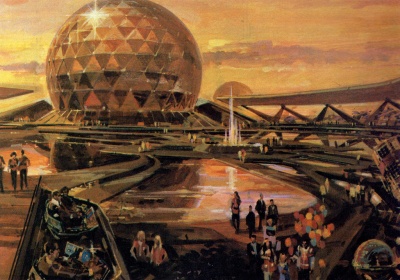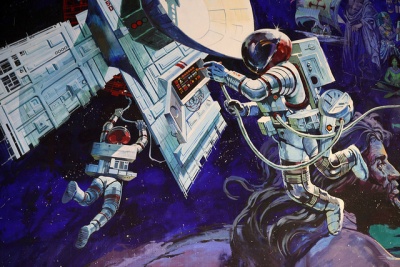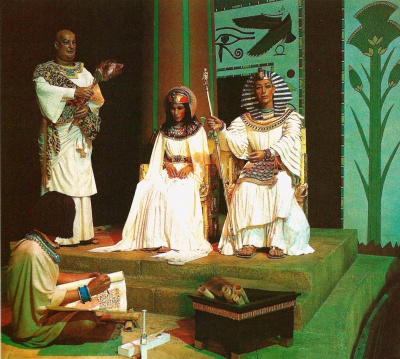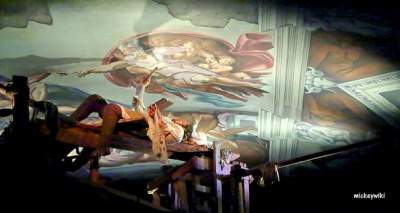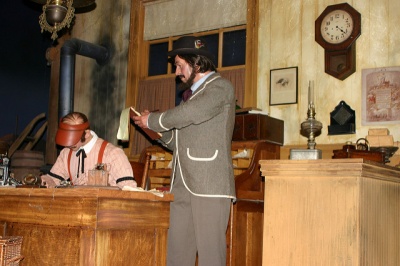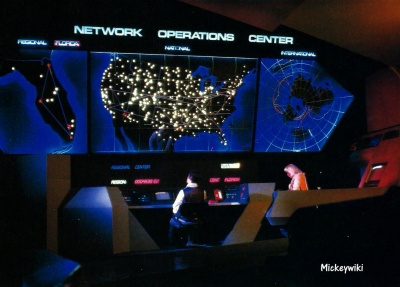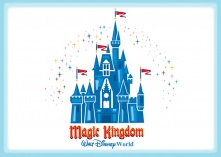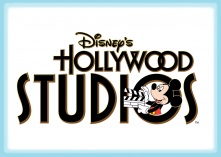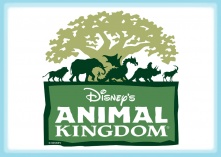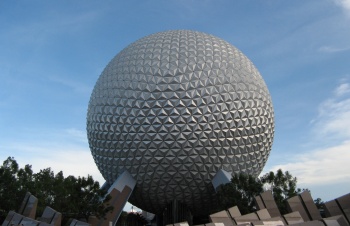The Mickey Wiki: Your Walt Disney World Encyclopedia!
The Mickey Wiki: Your Walt Disney World Encyclopedia!
Spaceship Earth[edit]
Spaceship Earth is a pavilion and an attraction located in World Celebration within Epcot.
Conception and Pavilion History[edit]
Spaceship Earth was a part of Disney’s plans for EPCOT Center since the theme park's inception. Unlike other pavilions which went through a series of redesigns and changes, Spaceship Earth remained essentially the same throughout its development. One of the few changes that did occur between the time that the pavilion was conceived and constructed involved the shape that Spaceship Earth would take. As seen in the 1978 EPCOT Center model, originally, Imagineers had planned on Spaceship Earth being a dome, with the attraction's show building located south of the pavilion. [1].
Due to the fact that plans for the Spaceship Earth attraction called for a finale that simulated a trip through space, Disney Imagineers felt that they would need to move guests "up" in the pavilion. Furthermore, Disney decided that simply entering the domed pavilion and boarding the ride was not dramatic enough [2]. In order to solve these issues, Imagineers eventually decided that instead of taking the shape of a geodesic dome, Spaceship Earth would be constructed as a geodesic sphere, something never done before [2].
Although the pavilion was designed to look like a seamless sphere, Spaceship Earth was actually constructed in two parts[2]. The top half of the dome sits on a steel square ring, which itself is set atop the pavilion's "legs". The bottom half of the dome was then attached to the bottom of the ring, giving the illusion that Spaceship earth is a monolithic structure[2].
Besides being constructed out of two separate halves, Spaceship Earth was also made of two separate spherical layers. The inside sphere of the pavilion was made of steel pyramid-shaped pipes[2]. This sphere was then covered by an outside sphere that was made of Alucobond pyramids (a polyester plastic) which was then covered in two sheets of aluminum[2]. This design was chosen so that the inner sphere (which houses the attraction) would be protected from the elements[2]. Furthermore, this design solved the issue of runoff water. As Disney did not want water pouring off the sides of the 18 story pavilion, gaps were left in-between the Alucobond pyramids, so that the water could run through them and into a gutter system (which would eventually deposit the water into the World Showcase Lagoon) [2].
It took construction workers 26 months and almost 40,800 labor hours to build Spaceship Earth [2]. When it was completed, in Spaceship Earth Disney not only an icon for EPCOT Center, but also the world’s first geodesic dome. Both the pavilion and the attraction housed within, were ready for EPCOT Center's opening day- October 1, 1982 [3].
The structure of the pavilion itself remained unchanged until 1999, when a large Mickey hand holding a wand was added to the top of Spaceship Earth [4]. The wand was dedicated "2000" in celebration of the new millennium, before the dedication was changed to "Epcot" in 2001 [4]. The Mickey hand and wand remained atop Spaceship Earth until it was removed in 2007, just in time for Epcot's 25th anniversary[4].
On October 1, 2021, Disney unveiled Spaceship Earth's new "Points of Light" lighting package [5]. As a part of these changes, nearly 2000 LED lights were added to the pavilion's exterior, allowing Spaceship Earth's reflective panels to illuminate with light. Throughout the night, a special Beacon of Magic sequence is also performed on Spaceship Earth, featuring a unique narration and different light displays.
Attraction History[edit]
Spaceship Earth’s storyline and original script were written by author Ray Bradbury [6], who came up with an elaborate version of “Man and his Spaceship Earth” (as the attraction was then called) in 1977 [7] [8]. Other consultants and advisers included academics from: the Los Angeles' Huntington Library, University of Southern California, University of Chicago, and the Smithsonian Institute [9] also contributed to the creation of Spaceship Earth.
Much like the pavilion, the storyline for the Spaceship Earth attraction remained fairly consistent throughout its development. In the 1980 booklet titled Walt Disney World EPCOT Center, Spaceship Earth is described:
The above description correlates very closely to the attraction that would eventually open to guests. In fact, the 1982 book also titled Walt Disney World EPCOT Center describes basically the same attraction, albeit now inside the geodesic sphere:
One change that did occur to the storyline of Spaceship Earth, involved the attraction's finale. The original plans for the finale called for guests to visit a moon base, where they would visit a futuristic space station under construction [10]. Although unconfirmed, it has been speculated that issues with the forced perspective caused the planned finale to be scrapped. Despite the fact that the scene was never installed, lunar rock cutouts created for the scene were left behind [11].
Throughout its history, Spaceship Earth has always featured a dark ride attraction that takes guests through the history of communication. The pavilion was first refurbished in 1986, with subsequent refurbishments taking place in 1994 and 2007. Following each refurbishment, the attraction has been given a new script, a new narrator, and a new finale.
When Spaceship Earth opened in 1982 it was sponsored by Bell Systems. By 1984 however, the company was broken up and AT&T (Bell's parent company) assumed sponsorship of the pavilion. AT&T continued to sponsor the pavilion until 2004, when the company decided not to renew their contract. Subsequently, in 2005, Siemens assumed sponsorship of the pavilion. The company's sponsorship of the attraction ended in October of 2017 [12].
Listed below is a more detailed description of the differences between the four versions of Spaceship Earth.
Original Incarnation: Vic Perrin or Larry Dobkins (1982-1986)[edit]
- NOTE: In 2008 Imagineer Mary Sklar disagreed with the long held notion that Vic Perrin was the narrator of the 1982 version of Spaceship Earth. Marty instead claimed that Larry Dobkins was the narrator. With no official credit given, it is currently impossible to know for sure who narrated the attraction.
The queue for the original Spaceship Earth attraction began with guests entering the pavilion, and walking up a short ramp. On the walls around them, two large posters showed Spaceship Earth at night and read "Ride the Time Machine from the Dawn of Civilization to the Beginning of Our Tomorrow. SPACESHIP EARTH." Nearby, a large mural showed astronauts working on a satellite, with Earth in the background. The mural was framed with small pictures depicting cavemen, Romans, Egyptians, the printing press, and finally modern humans. After passing through the queue, guests would board small blue ride vehicles, beginning the attraction itself.
After guests boarded, the vehicles guests entered a dark tunnel and began to ascend. Here, all guests could see was a purple cloud with stars all around it. A flash of lightning would periodically strike from the cloud, and the narrator would begin:
When the vehicles reached the top of the tunnel, guests could see images of cavemen fighting Woolly Mammoths. The narrator informed guests that they were entering the ancient caves, where humans first interacted. A scene showing an ancient medicine man talking to other cavemen could be seen here, with cave paintings showing the first humans “writing” their thoughts down. The narrator then acknowledged the Woolly Mammoth scene, informing guests that humans used communication in order to survive. The narration in this scene stated:
As the ride vehicles moved forward, guests could see an Egyptian making papyrus (sometime between 1567 - 1085 B.C.). Across the way, an elaborate Egyptian building could be seen, with Hieroglyphs decorating the archways. Further down the way, a Pharaoh was shown dictating to a scribe. His wife sat next to him, as servants fanned the royal couple. The narrator then spoke, saying:
At this point, the scene shifted to a seaport in the ninth century B.C.. Here, two Phoenician sailors could be seen trading goods and information from their two connected boats. On the right, guests could see the ocean with stars shining on the horizon. The narrator told guests:
The ride vehicles then moved forward in time, to Greece in 428 B.C.. Here, a scene depicting a Greek theater could be seen, with two men acting out Oedipus Rex. The narrator then spoke once again:
As guests continued their journey through time, they came upon a Roman solider riding in a chariot. He was exchanging information with another man (who was wearing a toga). In the background, a painted wall depicted Rome, as another chariot passed by. The narrator then said:
As the ride vehicles carried on, guests could see ruins of a smoldering building. The narrator informed guests that the excess of Rome had led to its destruction. A scene showing the Islamic wise men sitting in a circle discussing books was then shown. To their left, was a library with unfilled shelves, inside of which two men could be seen reading. Here the narrator informed guests:
Continuing forward into the Dark Ages, on guest's right, an astronomer could be seen standing on a balcony, investigating the stars. Further down the path, two Benedictine Monks were shown copying text by hand, with the monk on the right having fallen asleep on the job. The narrator once again spoke, saying:
As guests entered the Renaissance scene, Johann Gutenberg and his associate could be seen working on the printing press. Guests then moved forward to Italy in the 16th century. To the right, a man was shown reading a book to two others, while just beyond them, two musicians played music in front of a small Italian town. On guest's left various artists were work. One was mixing paint, one painting fruit, and one sculpting. Further ahead on the left, guests could see Michelangelo lying on scaffolding, painting the ceiling of the Sistine Chapel. A conveyance system brought buckets of paint up to the artist as he painted. The narration for the Renaissance continued:
Following the Renaissance, guests moved forward in time to the 18th and 19th century. The narrator spoke of this transition saying:
The first thing that guests would see in the modern era was the steam powered printing press, which was invented by William Bullock in 1863. While a man inspected the newspaper that came out of the press, further on, a young newsboy stood on a street corner selling a stack of New York Daily newspapers. As the vehicles continued on, guests could see a man dictating a telegram to another man who sent it out, while a train passed by on a railroad. On their left, guests could then see telephone wires stretching all across the scene, and various phone conversations could be heard.
Moving forward, guests passed by a woman sitting in a cinema ticket booth. Three screens on her left showed old black and white movies. The first screen showed a movie about a runaway trolley, the second showed two people dancing, and the final screen showed the Disney film 20,000 Leagues Under the Sea. Across the way, guests could see a scene depicting the WDP (Walt Disney Productions) radio station, where a man and a woman could be found acting out a radio show inside of a sound booth. Outside the booth, an engineer monitored the sound level. To the right of the scene, a radio tower was shown, with waves emanating from it.
As time progressed, the vehicles passed a scene depicting a mother, father and daughter watching TV in their living room. Four other televisions hung on the wall behind the family, which would change channels, showing various television shows. Shows that could be seen here included:
- Ozzie and Harriet
- 1964 NFL Colts vs. Browns Championship Game
- Ed Sullivan with the Harlem Globetrotters
- Walter Cronkite
- Walt Disney introducing an episode of The Wonderful World of Color.
Following the television scene, the narrator once again spoke.
Guests then could see The Network Operations Center, where network lines and satellites were monitored. The center housed a map of Florida, The United States, and even a view of the entire globe (from the North Pole). A man sat in front of these maps watching them, while a woman was seated to his right. The narration in this scene noted:
The ride vehicles then entered a tunnel, which featured high speed lights flying by. Here the narrator said:
- ↑ http://progresscityusa.com/2011/06/19/epcot-origins-a-model-future-1978/
- ↑ 2.0 2.1 2.2 2.3 2.4 2.5 2.6 2.7 2.8 http://land.allears.net/blogs/jackspence/2010/01/spaceship_earth_epcots_icon_pa_2.html
- ↑ http://thisdayindisneyhistory.homestead.com/epcotgrandopening.html
- ↑ 4.0 4.1 4.2 http://www.lostepcot.com/spaceshipearth.html
- ↑ https://www.wdwmagic.com/attractions/spaceship-earth/news/30sep2021-a-look-at-spaceship-earths-new-points-of-light.htm
- ↑ https://disneyparks.disney.go.com/blog/2012/06/honoring-ray-bradburys-contribution-to-epcot/
- ↑ http://jimhillmedia.com/editor_in_chief1/b/jim_hill/archive/2005/03/07/553.aspx
- ↑ http://epcotexplorer.tumblr.com/post/99489612171/introspection-and-symbolism-an-appreciation-of
- ↑ http://www.intercot.com/edc/SpaceshipEarth/index.html
- ↑ http://epcotexplorer.tumblr.com/post/22592963788/spaceship-in-spaceship-earth-original-plans-for. AUTHORS NOTE: This intended finale can be seen in concept art and the attraction's mural
- ↑ https://www.youtube.com/watch?v=OWPZhjyd4QM&t=6s>
- ↑ http://www.orlandosentinel.com/business/tourism/os-bz-disney-epcot-siemens-20170703-story.html
|
|||||||||||||||||||||||||||||||||||||||
Navigation menu
- This page was last modified on 16 November 2019, at 18:23.
- This page has been accessed 752,240 times.


